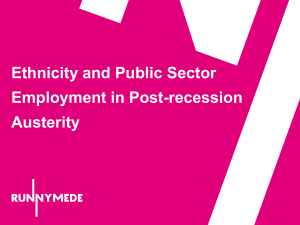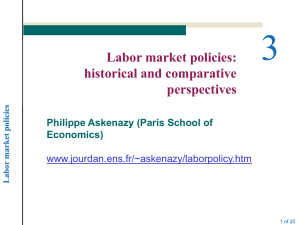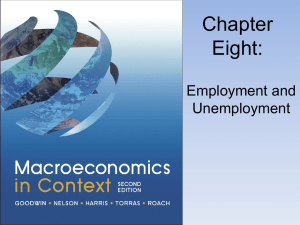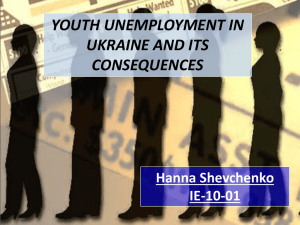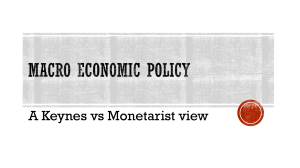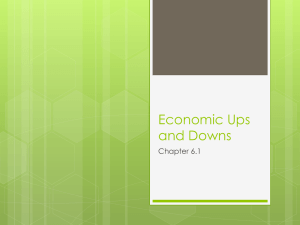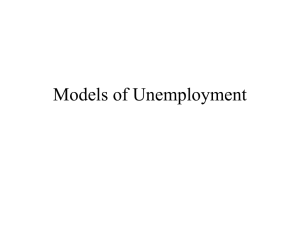"Ineguaglianze Globali", 22 Giugno 2011, Sarnico
advertisement
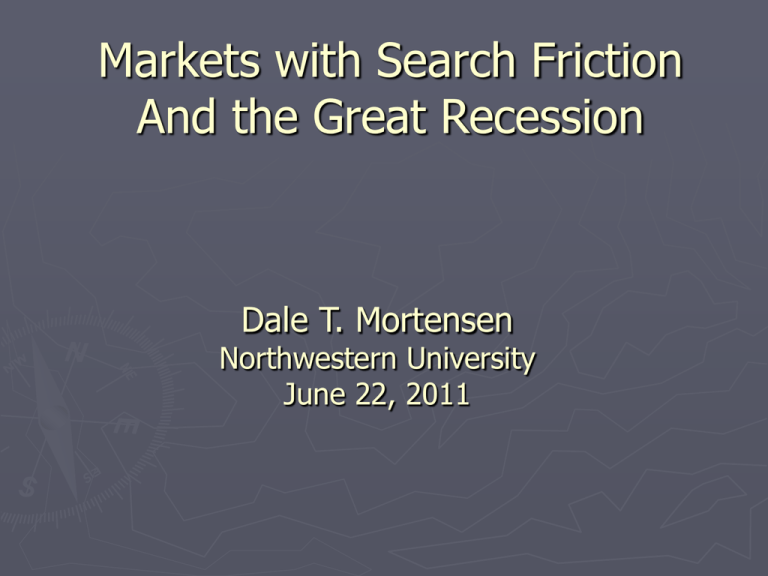
Markets with Search Friction And the Great Recession Dale T. Mortensen Northwestern University June 22, 2011 Outline ► Introduction ► The Flows Approach Search Equilibrium The Bench Mark DMP Model The Great Recession Summary ► ► ► ► Introduction ► What are search frictions? What role do they play in the operations of markets. ► Examples: Buying our apartment and selling our house. Investment in time and effort are required now in return for future benefits. ► Lesson: An acceptable house, partner or job is one that offers an expected stream of future benefits that has a value in excess of the option to search for an even better one. The Flows Approach ► From the viewpoint of the classical “supply and demand” approach to markets, unemployment arises only when wages are “too high.” ► But in fact, large flows of workers are finding (losing) jobs…in both ‘good’ and ‘bad’ times. ► The simultaneous existence of unemployment and vacancies reflect the fact that it takes time to match workers and jobs. ► Unemployment (employment) is a stock that tends toward a level that balances large inflows with large outflows. Labor Market Flows The Matching Function and the Beveridge Curve ► The matching function: A postulated relationship between search and recruiting inputs and jobworker matching rate which supposes that the job finding rate is an increasing function of the ratio of vacancies to unemployment. ► Flow balance equation: Unemployment tends to the value that balances inflows and outflows ► Together these explain the so-called Beveridge Curve, a negative association between vacancies and unemployment. The Empirical Job Finding Rate and Beveridge Curve Source: Shimer (2005). Search Equilibrium ► The ‘free entry’ condition: Jobs are created up to the point where the marginal vacancy has zero value. Implies that fewer vacancies are created per unemployed worker when the future wages promised to workers are higher given demand. ► The bargaining outcome: Workers and employers share the surplus value of a match. Implies that wage demands are higher when it is easier to find a job – when the vacancies to unemployment ratio is higher. ► A search equilibrium is a vacancy to unemployment ratio and a wage pair that balances these two forces. The DMP Model Wages Free entry condition Bargaining outcome 0 Vacancies/Unemployment The Value of a Match… Depends on two uncertain variables ► The financial crisis affected both ► ► The expected stream of future match revenue. The expected rate at which this stream is discounted. Households reduced consumption to replenish wealth. Banks restricted lending and increase effective interest rate spread that borrowers pay. The expected value of a match fell for both reasons generating a drop in the vacancyunemployment ratio a move down the Beveridge curve. The Great Recession A Negative Demand Shock Wage Promise 0 Vacancies/Unemployment US Beveridge Curve Dec 2000-April 2011 Vacancy rate Unemployment rate The Long Slump: Has the “natural rate” of unemployment increased from 5% to 8-9%? ► ► “What does this change in the relationship between job openings and unemployment connote. In a word, mismatch. Firms have jobs, but can’t find appropriate workers…the Fed does not have the means of transforming construction workers into manufacturing workers.” …Narayana Kocherlakota (Minneapolis Fed Pres., address, 8/17/2010) “Instead, the elevated unemployment rate appears to reflect mainly cyclical factors, particularly the lingering shortfall of consumption spending and business investment.” …Chistina Romer (Former Econ Council Advisor Chair, NY Times, 4/10/2011) Evidence for “Mismatch” ► The Beveridge curve has shifted out…reflecting the fact that it may have become harder to match workers and job. ► Construction and finance were adversely affect, employment fell by about only 1.3 million in these sectors but unemployment increased by 6 million. ► Housing market problems (11 million mortgages “under water”) have reduced mobility … but labor demand has fallen in all regions. ► The DMP model does suggests that mismatch can account for about 2 of the 5 point increase in the unemployment rate. … Barlevy (2011) Beveridge Curve Shift Source: Barlevy, Federal Reserve Bank ofChigago Unemployment Effect of Shift Source: Barley, Federal Reserve Bank of Chicago Evidence for Deficient Demand ► Household investment in housing is depressed by the “overhang” from by the construction boom and so households wish to reduce debt rather than consume. ► Corporations are not investing in hiring and training workers which suggests that expectations about the future prospects remain depressed among employers and labor cost uncertainties. ► However, capital expenditures are picking up reflecting a fall in equipment prices which may suggest substitution of capital for labor. Role for Government Policy? ► “In the Great Slump that began at the end of 2007, low inflation resulted in an only slightly negative real (interest) rate when full employment called for a much lower real rate because of declines in demand.” ► “Are there any policy moves available now that would speed up the slow recovery?” “Monetary policy has gone to its limits in pushing the interest rate down.” “The Government seems to lack the logistical tools to expand government expenditures significantly and the political wind is blowing in the wrong direction to push that lever very hard.” … Robert E. Hall, 2010 AEA Presidential Address Conclusions ► Some ‘mismatch’ exists but can’t explain all of the data, … still it may be a problem in the future. ► The real problem is that demand for goods and services has not recovered because real interest rates have remained too high. ► Fiscal stimulus and/or inflation would help but are not politically feasible.



